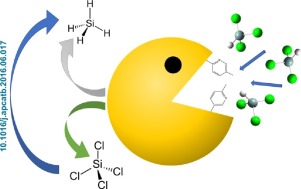Applied Catalysis B: Environment and Energy ( IF 20.2 ) Pub Date : 2017-10-29 , DOI: 10.1016/j.apcatb.2017.10.062 Andrey V. Vorotyntsev , Anton N. Petukhov , Dmitriy A. Makarov , Evgeny N. Razov , Ilya V. Vorotyntsev , Alexander V. Nyuchev , Natalia I. Kirillova , Vladimir M. Vorotyntsev

|
The variety of catalysts based on macroporous ion exchange resins using 2-methyl-5-vinylpyridine cross-linked with divinylbenzene (2M5VP/DVB) was investigated in the disproportionation of trichlorosilane (TCS) in a continuous-flow reactor. The effects of the reaction temperature and surface area on TCS disproportionation kinetics was invesitigated using three types of catalysts based on 2M5VP/DVB with a different pore ratios (toluene(tol)/heptane(hep)) and in the temperature range of 333.2 K and 453.2 K. The results indicate that within this range, the higher reaction temperatures result in an increase in the conversion rate to TCS at equilibrium. The effects on the specific catalyst surfaces were determined and the catalyst (2M5VP/DVB-hep/tol) with the highest specific surface area exhibited better catalytic activity. Variable temperature studies on the catalytic activity of 2M5VP/DVB-hep/tol revealed an activation energy of 24,06 ± 0.72 kJ mol−1 for 2M5VP-hep/tol and 34.30 ± 1.03 kJ mol−1 for Amberlyst A-21 resins. TCS disproportionation was investigated using a non-stationary process and showed the desorption of STC from the active sites of the catalyst to be the rate determining step. Using FTIR analysis, we have already established that the resin after exposure to HCl or TCS undergoes protonation of the nitrogen atom in the pyridine ring with intermediate formation of N+H⋯Cl−/N+H⋯SiCl3−. Based on the reaction data obtained in this study, a probable mechanism of the reaction has been proposed.
中文翻译:

基于2-甲基-5-乙烯基吡啶和二乙烯基苯的离子交换树脂在三氯硅烷催化歧化反应中的合成,性能及机理
在三氯硅烷(TCS)在连续流反应器中的歧化中,研究了基于大孔离子交换树脂的催化剂,该催化剂使用与二乙烯基苯交联的2-甲基-5-乙烯基吡啶(2M5VP / DVB)。研究了反应温度和表面积对TCS歧化动力学的影响,使用了三种基于2M5VP / DVB的催化剂,它们具有不同的孔比(甲苯(tol)/庚烷(hep)),并且在333.2 K 453.2K。结果表明,在此范围内,较高的反应温度导致平衡时TCS的转化率增加。确定了对特定催化剂表面的影响,具有最高比表面积的催化剂(2M5VP / DVB-hep / tol)表现出更好的催化活性。-1用于2M5VP-HEP / TOL和34.30±1.03千焦耳摩尔-1为大孔树脂A-21树脂。使用非平稳过程研究了TCS歧化作用,结果表明,STC从催化剂活性部位的脱附是决定速率的步骤。用FTIR分析,我们已经建立了暴露于HCl或TCS后的树脂经历与N-的中间形成吡啶环的氮原子的质子化+ ħ⋯氯- / N + ħ⋯的SiCl 3 - 。根据在这项研究中获得的反应数据,已经提出了反应的可能机理。


















































 京公网安备 11010802027423号
京公网安备 11010802027423号